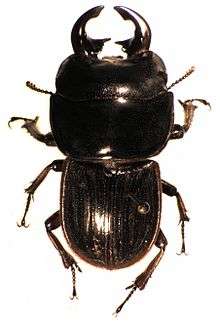Geodorcus helmsi
| Helms's stag beetle | |
|---|---|
 | |
| Scientific classification | |
| Kingdom: | Animalia |
| Phylum: | Arthropoda |
| Class: | Insecta |
| Order: | Coleoptera |
| Family: | Lucanidae |
| Subfamily: | Lucaninae |
| Genus: | Geodorcus |
| Species: | G. helmsi |
| Binomial name | |
| Geodorcus helmsi (Sharp, 1881) [1] | |
| Synonyms[2] | |
| |
Geodorcus helmsi or Helms's stag beetle is a large, slow-moving and flightless species of stag beetle in the family Lucanidae. It is endemic to New Zealand.
Description
Geodorcus helmsi varies in colour from black to brownish-black. Its dorsal surface can vary from dull to glossy. Male individuals range in size from 17.5-44.0mm, including mandibles. Females are smaller with less conspicuous mandibles. They range in size from 16.5-27.5mm. In larger male specimens, the mandibles are long, slender and strongly arched. The mandibles have a conspicuous tooth near their base. It is distinguished from other Geodorcus by its straight and not arched tibae and five setose ridges on the elytra. [3] Like other stag beetles, they show sexual dimorphism.
Distribution
Geodorcus helmsi is the most widespread of the ten species of Geodorcus having been collected from Karamea on the northern West Coast of New Zealand to the south of the South Island and as far north as Tapanui in West Otago. It has also been collected from islands in Fiordland and Stewart Island. Adults have a wide altitudinal range from sea level to 1400m.[3]
Habitat
All Geodorcus species are mainly nocturnal and hide underneath fallen log stones or leaf litter on the forest floor.[4] At night D. helmsi have been seen active on tree trunks, chewing at the bark to get access to the exudate. This species occupies a highly variable habitat, including forest and tussock-dominated high country.[4]
Diet
The feeding ecology of adult G. helmsi may be highly variable, due to their occupation of a wide range of habitats from forest to the tussock zone in the high country. Adults have been observed on tree trunks feeding on sappy exudate from wounds in the bark[4] Larvae of other lucanid beetles commonly eat rotting wood at the surface. Geodorcus larvae have been observed to have large quantities of humus inside their gut.[3]
Life cycle
In New Zealand stag beetles, there is no published information about the duration or timing of oviposition, larval, pupal and adult stages of the life cycle. Copulation has been observed in October.[3] Larvae of Geodorcus have been seen under decaying logs, occupying a gallery in the soil layer. They are "C" shaped, slow moving and photophobic.[4]
Conservation
All Geodorcus species are protected under Schedule 7 of The 1953 Wildlife Act, making it an offense to hunt, kill or possess a specimen.[5] Predation by introduced rats has reduced the population density of G. helmsi. On islands where rats are present, only their remains have been found, .[3] This species has been found to make up to 27% of the dry weight of feral pig stomach contents.[6]
References
- ↑ Sharp, David (1881). "Some new species and genera of Coleoptera from New Zealand". Entomologist's Monthly Magazine. pp. 46–51.
- ↑ "Catalogue of Life". Catalogue of Life. Retrieved 2 November 2016.
- 1 2 3 4 5 Holloway, B.A. "Lucanidae (Insecta: Coleoptera)" (PDF). Landcare New Zealand. Landcare Research. Retrieved 3 November 2016.
- 1 2 3 4 Sherley, Greg; Green, Chris; Owen, Keith (1994). "Distribution, conservation status and some features of the natural history of Dorcus Stag beetles (Coleoptera: Lucanidae)" (PDF). Science and Research Series (75). Retrieved 4 November 2016.
- ↑ "Wildlife Act 1953". New Zealand Legislation. Parliamentary Counsel Office. Retrieved 4 November 2016.
- ↑ Parkes, John P.; Easdale, Tomas A.; Williamson, Wendy M.; Forsyth, David M. (21 November 2014). "Causes and consequences of ground disturbance by feral pigs (Sus scrofa) in a lowland New Zealand conifer–angiosperm forest" (PDF). New Zealand Journal of Ecology. 39 (1): 34–42. Retrieved 4 November 2016.